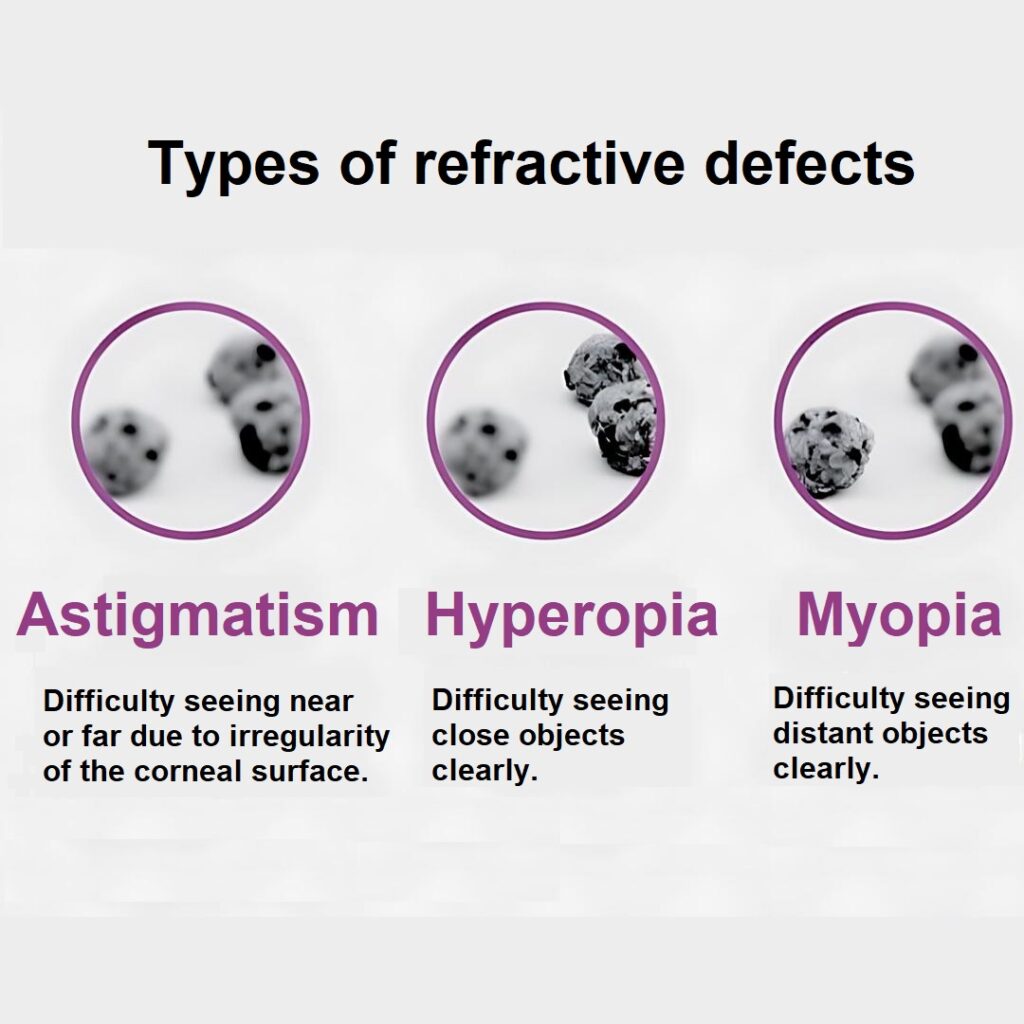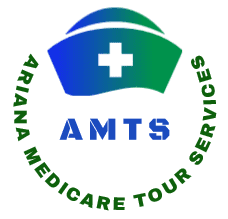Refractive errors are a common problem that affects the quality of vision in both adults and children. These errors range from nearsightedness, farsightedness, and astigmatism, and affect a person’s ability to see things clearly. In Shiraz, Basir and Panajaster Hospitals provide advanced and specialized medical services to treat these conditions, with a focus on using the latest technologies and medical devices to ensure the best possible health care.

Article Contents
- Introduction.
- Definition of refractive defects of the eye.
- Effective factors in refraction and eye degree.
- Types of refractive errors of the eye.
4.1. Hyperopia.
4.2. Myopia.
4.3. Presbyopia.
4.4. Astigmatism. - Methods of correcting refractive error.
5.1. Glasses.
5.2. Contact lenses.
5.3. Refractive surgery.
5.3.1. Common methods of refractive error surgery:
● LASIK.
● Femto LASIK.
● PRK.
● LASEK
● إEpiLASIK
● Intraocular lens implantation, (Phakic IOL). - Refractive errors in children.
- What is the most appropriate method?
1. Introduction
Refractive errors are a common eye problem that usually causes decreased vision clarity, visual overexposure, or two types thereof. When light reaches the eye, it must pass through the cornea and lens of the eye and form an image on the retina. Stay with Ariana to provide you with everything you need to know about refractive errors.
2. Definition of refractive defects of the eye
Refractive defects of the eye are defects that appear in the optical system of the eye and prevent the normal refraction of light. Therefore, due to the lack of correct refraction of light, a clear and accurate image of surrounding objects is not formed on the retina, and as a result the person faces problems such as myopia, farsightedness, presbyopia, and astigmatism and suffers from poor vision. To get an accurate diagnosis and correct treatment for refractive disorders and errors, you should visit an experienced and skilled ophthalmologist in Shiraz, Iran. Because if you go to an experienced and skilled doctor, he will suggest the best treatment method and you will be satisfied with the results of the treatment.
3. Effective factors in refraction and eye degree

In general, there are three factors that make the image clear on the retina. These three factors are:
- Corneal shape.
- Eye size.
- The power of the eye lens.
In order for a person to be able to see without wearing glasses, these three factors must be proportional to each other. Otherwise, refractive errors will result. In fact, the refractive errors of the eye are measured using a device (diopter), which determines the degree of glasses. The higher the degree of nearsightedness or farsightedness, the higher the degree of glasses.
4. Types of refractive errors of the eye

There are different types of refractive errors because they do not create the same conditions for all people; These include hyperopia, myopia, presbyopia, and astigmatism, each of which we’ll explain below.
4.1. Hyperopia
Farsightedness is one of the disorders that many people suffer from. These people see distant objects more clearly than close objects. Hyperopia is as likely to develop as myopia in people of all ages, including children and adults. According to studies, people whose families and relatives have farsightedness are more susceptible to infection.
- The symptoms of farsightedness are not the same for all people, but symptoms such as headache, eye fatigue, misalignment, and disturbance in seeing near objects are common.
4.2. Myopia
It is one of the refractive errors of the eye, which means that the patient’s eye can recognize writings and symbols at a close distance, but it cannot recognize them at a long distance (compared to healthy people).
This disorder usually occurs in childhood and reaches its peak in adolescence due to rapid growth. According to research, people with myopia will not have much changes at the age of 20 to 40 years. People with high myopia are certainly at greater risk and surgery may be the only way to treat them. It is very important to conduct regular and frequent eye examinations in these people, because with this work this disorder can be controlled to a greater extent and treated more quickly.
4.3. Presbyopia
As the name of this disorder suggests, presbyopia occurs in old age; In youth, the eye’s lens is very soft and flexible and can easily change shape. With time and age, the lens becomes more rigid and eventually cannot deform as easily. For this reason, close-up writing becomes very difficult to read and creates disturbances; Presbyopia may occur in people over 35 years of age.
- Presbyopia disorders include eye fatigue, headaches, inability to read letters closely, difficulty seeing close objects, etc. People who exhibit these symptoms should go to an ophthalmologist as soon as possible so that treatment can begin after the examination.
4.4. Astigmatism
In this refractive error, light is focused on the retina at two points after passing through the cornea and lens. Its cause is irregularity in the structure of the cornea and the ovality of the cornea. To correct this, it is enough to make the cornea more spherical.
- Signs and symptoms of this disorder are headache, blurred vision, difficulty driving especially at night, distraction and eye fatigue.
5. Methods of correcting refractive error
5.1 . Glasses
Using glasses is the easiest way to correct refractive errors. It is easy to change the lens pitch and at the same time protect the eye from sunlight. To correct presbyopia, bifocal glasses can be used, the lower part of which is used for reading.
5.2. Contact lenses
Currently, there are many contact lenses available. Choosing the right type of intraocular lens depends on the type of refractive error, lifestyle and usual activities of the person. Contact lenses and glasses correct vision by focusing light on the retina.
Eye exercises, vitamins and pills
(There is not enough scientific evidence that these methods are effective in improving eye score)
5.3. Refractive surgery

Most surgical methods for refractive errors improve vision by correcting the curvature of the cornea (the clear window in front of the eye). In the treatment of myopia, the curvature of the cornea is reduced through surgery, and the refractive power of the cornea is reduced, resulting in the formation of an image on the retina. In farsightedness surgery, exactly the opposite happens. In the case of astigmatism, where the curvature of the cornea is different in one direction than the other, surgery corrects the curvature of the cornea in the astigmatism axis and makes the curvature equal in all axes.
5.3.1. Common methods of refractive error surgery:
- LASIK.
- Femto LASIK.
- PRK.
- LASEK.
- EpiLASIK.
- Phakic IOL.
We talked about the above-mentioned methods in the vision correction article, so go there to learn more about these methods.
6. Refractive errors in children

Usually, people whose children have refractive errors face many questions; Some of these questions fall into the category of whether eye weakness in children can be treated. Doesn’t this affect children’s learning? Who is the best ophthalmologist to treat this type of disorder? But that’s a good thing. And the …
Refractive defects and lazy eye in children were among the most common disorders in the past and even today; If this vision disorder is not recognized and treated quickly, there is a possibility that it will turn into lazy eye in adulthood. Lazy eye means decreased vision in the eye despite correction of refractive errors; Since this most often occurs in only one eye and the lesion cannot be seen intuitively in the eye, it is difficult to detect.
This problem can be caused by different refractive errors in the eye; Sometimes, more work is done than in the eye that doesn’t have a problem, and the person eventually doesn’t recognize which eye has the disorder. When lazy eye is not treated under the age of three, it is sometimes difficult, and sometimes impossible, to treat it at an older age.
7. What is the most appropriate method and who are the most skilled doctors and surgeons in treating refractive errors in Iran in Shiraz?
Before selecting the appropriate method, it is necessary to perform a complete eye examination to determine things such as the amount of refractive error, corneal thickness, corneal characteristics and to ensure the health of the eye. Then by considering your age, occupation, physical condition, medical history and other information, you can decide on the best option. It is best to leave this choice to the ophthalmologist and consultants in this regard in Iran in the city of Shiraz and Tehran.
Reference:
Refractive Errors”. NEI. October 2010. Archived from the original on 28 July 2016. Retrieved 29 July 2016
Care of the Patient with Amblyopia” (PDF). Archived from the original (PDF) on 19 August 2016. Retrieved 17 February 2020
Dandona, R; Dandona, L (2001). “Refractive error blindness”. Bulletin of the World Health Organization. 79 (3): 237–43
Refractive Errors in Children – American Association for Pediatric Ophthalmology and Strabismus”. aapos.org. Retrieved 2023-10-30
دکتر محمد پاکروان (۱۳۸۵)، بیماریهای شایع چشم به زبان ساده، فرهنگ فردا
Read more about other articles in the medical fields (Cosmetics and Medical).
- Hair Transplantation in Iran
- Rhinoplasty (Nose Job in Iran)
- Face Lift Surgery (Rhytidectomy) in Iran
- Breast Lift in Iran
- Chin Surgery in Iran
- Liposuction in Iran
- Tummy Tuck (Abdominoplasty) in Iran
- Butt Augmentation (Brazilian butt lift)
- Breast Augmentation in Iran
- Eye Care in Iran
- Cataract Surgery in Iran
- Diabetic Retinopathy Treatment in Iran
- Heart Surgery in Iran
- Knee Replacement in Iran
- Eyelid Surgery in Iran
- Safe Abortion in Iran
- Fertility Treatment in Iran


